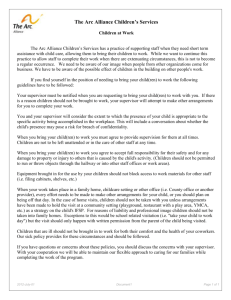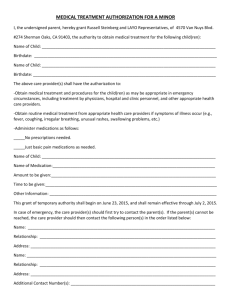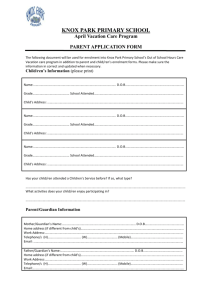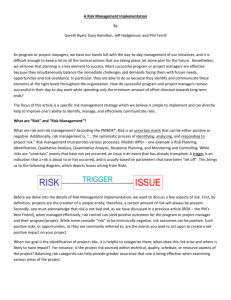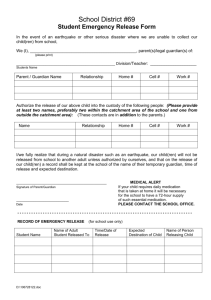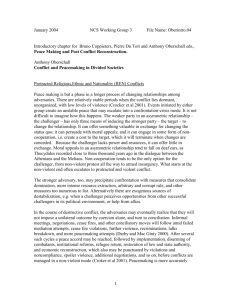File: Peaceoutline
advertisement
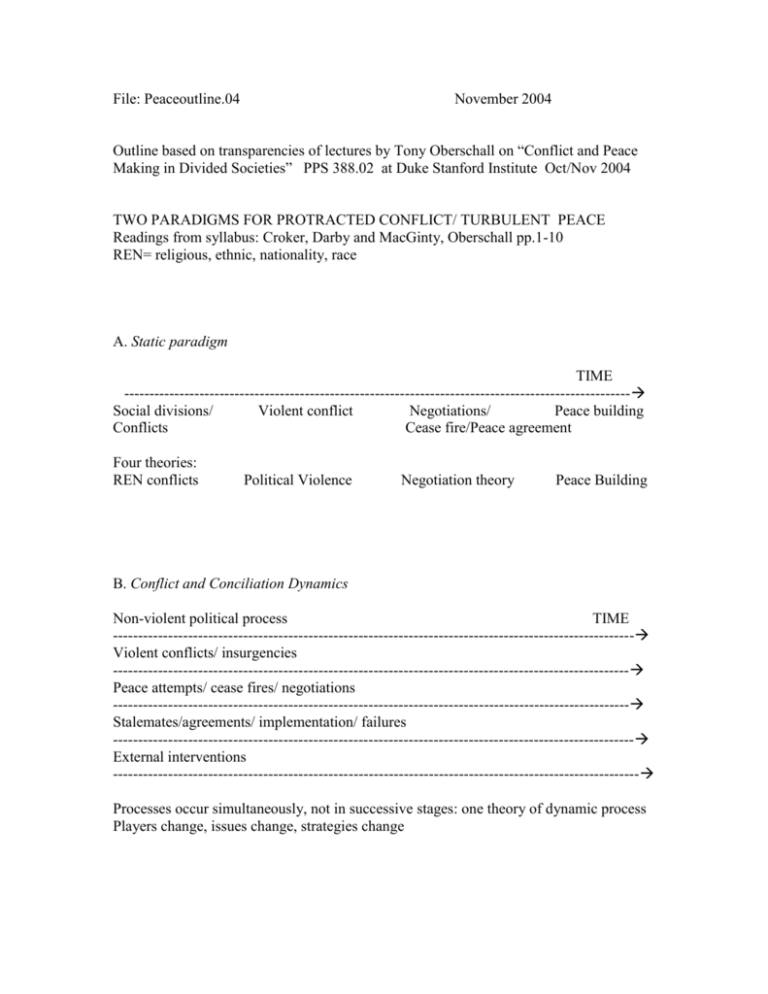
File: Peaceoutline.04 November 2004 Outline based on transparencies of lectures by Tony Oberschall on “Conflict and Peace Making in Divided Societies” PPS 388.02 at Duke Stanford Institute Oct/Nov 2004 TWO PARADIGMS FOR PROTRACTED CONFLICT/ TURBULENT PEACE Readings from syllabus: Croker, Darby and MacGinty, Oberschall pp.1-10 REN= religious, ethnic, nationality, race A. Static paradigm TIME ----------------------------------------------------------------------------------------------------- Social divisions/ Violent conflict Negotiations/ Peace building Conflicts Cease fire/Peace agreement Four theories: REN conflicts Political Violence Negotiation theory Peace Building B. Conflict and Conciliation Dynamics Non-violent political process TIME -------------------------------------------------------------------------------------------------------- Violent conflicts/ insurgencies ------------------------------------------------------------------------------------------------------- Peace attempts/ cease fires/ negotiations ------------------------------------------------------------------------------------------------------- Stalemates/agreements/ implementation/ failures -------------------------------------------------------------------------------------------------------- External interventions --------------------------------------------------------------------------------------------------------- Processes occur simultaneously, not in successive stages: one theory of dynamic process Players change, issues change, strategies change CONFLICT AND CONCILIATION Readings: Oberschall, pp.1-10 A and B are adversaries. A is the target, B is the challenger (e.g. majority/minority). Asymmetric power relationship. There are contentious core issues (e.g. equality) Three means of status quo change for B: exchange, persuasion, coercion. If first two fail: coercion. If coercion, derivative issues arise (e.g. responsibility for violence), trust decreases, hostility increases New situation: core issues + derivative issues + lack of trust + much hostility Later: violent conflict, attempts to conciliate but violent conflict continues When conciliation advances to peace agreement, additional issues: recognition of adversary, negotiation norms, security and combatant disarmament, acceptance and legitimation of accord by publics, implementation of accord, social and economic reconstruction During protracted conflict and peace process above, there is issue accumulation: core issues + derivative + trust +procedural + recognition + security + legitimation + implementation + reconstruction . All have to be dealt with, each can undermine peace process. CONFLICT DYNAMICS: players, issues, strategies change Reading: Oberschall, pp.1-10 Issue accumulation (see above) Repression paradox: repression deters some, but creates more core and derivative issues which recruits non-participants and bystanders into active partisanship Mobilization for conflict by adversaries Polarization: moderates and extremists split in each group Grievance manipulation in elections, mass media Social psych. changes: fear, hate increase, trust decreases Crisis discourse: moral justification of violence Security dilemma for moderates, bystanders when state does not protect them in conflict External interventions Changes in conflict dynamics: differences between adversaries increase, difference within each increase with moderate/extremist polarization. Instead of one conflict between adversaries at start, there may develop three conflicts: between A and B, within A, within B. PEACE PACTING/ PEACE ACCORD Reading: Sisk Core issues in a peace accord: Constutional choice/stateness; Power sharing governance; Human rights; Autonomy, collective or group rights; Reform of institutions,e.g. justice, police, education, labor markets/employment; Normative dimensions: reciprocity and equity between adversaries in the settlement Derivative issues in the peace accord: DDR-decommissioning/demobilization/reconstruction; refugee issues; spoiler violence/security; implementation and monitoring/accountability; long term stable peace building. THE LOGIC OF ETHNICITY (REN) Readings: Kaufman, Hewstone and Cairns What is an ethnic group? (not all apply for every instance) Share name, collective identity Believe common descent (kin myth) Share common history, culture; ethnocentrism Sacred, religious, emotional attachment, not just interest Territorial attachment Collective myths sustain cognitive, emotional, symbolic ties Ethnicity withstands modernization, social change What explains relations between ethnic groups? Some are cooperative, others are or become exploitative, hostile, prejudicial, discriminatory. Why? 1. competition for scarce resources 2. relationship is domination/subordination, and not equality 3. social identity theory (Tajfel): even without ethnicity and without competition, solidarity and identity derived from group membership creates some in-group preference and derives satisfaction from unfavorable comparisons with out-groups. Groups striving to increase their social standing are a threat to others’ social standing and self-esteem. 4. Olson’s collective action theory. A heterogenous population dividing into groups with boundaries is beneficial to group members if there is more consensus on public goods within the group than in the population and at the same a diversity of individual talents and tastes in the group. Consensus on public goods cuts down political conflicts and creates low cost governance in shared institutions. Diversity in talents and tastes provides opportunities for gains in transacting within the group, and few incentives to transacting outside the group. Ethnic group frequently fulfill the Olson logic of group formation and persistence, and of group boundaries. Some other groups also fulfill the Olson criteria: clubs, religious sects, retirement and “gated” communities, cooperatives, etc. 5. Schelling’s paradox: voluntary choice in micro (interpersonal) relations can produce large, unintended consequences in macro (intergroup) relations. Example: when there are two groups, an in-group preference in both for 50 % of neighbors or more belonging to one’s group will in the long run result in 100% segregated living patterns (although everyone was satisfied with up to 50% of other neighbors). This paradox does not assume hostility, prejudice, rejection, but only a slight in-group preference. 6. Add together competition, dominance, identity theory, Olson logic and Schelling paradox, and it is quite likely that some ethnic relations will be conflictual. 7. Inhibitors to ethnic conflict are Participating in attaining common goals Building an overarching common identity Public policy that has incentives for sharing groups and institutions across ethnicity THEORIES ABOUT REN CONLICTS Reading: Kaufman, Collier, Oberschall, pp1-10 Ancient Hatreds (AH) Manipulative Elites (ME) Economic Roots (ER) Symbolic/Identity Politics (SP/IP) Spiral of Insecurity (SOI) Conflict Dynamics (CD) The structure of these theories is: REN Challenger(s) contest issues with Target(s), usually a government or a REN group that is in power. There are facilitating variables for the challenger (shared identity, capacity to organize, external support, geographic location…) and blocking variables that favor the target (strong state institutions, reform policies, external support…). The dynamics of contention (mixture of conflict and conciliation) consists of linked processes such as repression paradox, security dilemma, polarization … which lead to additional issues and problems, such as refugees and loss of power by moderates. Issues, players, strategies all undergo change in protracted conflict. Outcomes are characterized by state and constitution changes (secession, federal structure…); institutional changes and reforms, or unilateral imposition (challenger overthrows target, or target suppresses the challenger), or stalemates with renewal of conflict at a later time. CONFLICT MANAGEMENT STEPS Reading: same AH: separation, separate states, institutions ME: pressure from world leaders, outside states on political leaders ER: development, employment for long run peace SP/IP: language, cultural, education autonomy; construct inclusive identity SOI: assurances on security by outside states and international agencies, inspectors, monitoring CD: on top of core issues, derivative, security, legitimation, implementation, etc. issues have to be dealt with ARMED REN CONFLICTS IN 1990’S and LATER DIFFER FROM CONVENTIONAL WAR Readings: Kaldor, Collier, Ignatieff, Oberschall (terrorism) Conventional (old) wars between states and contemporary insurgencies and civil (new) wars differ: Unity of governance versus dual authority, anarchy, failed state An economy of war mobilization versus an economy of predation A professional army versus militias, paramilitaries, war lords, criminal gangs Targets are soldiers and military versus targets are civilians Goals are control of territory versus control of people and resources (war may become a way of life) Norms of war under Geneva Conventions versus atrocities, massacres, ethnic cleansing Termination of war via cease fire and peace treaty versus protracted war/turbulent peace Note that some civil wars combine aspects of both old and new wars. On all dimensions, peace making becomes more difficult in new wars. SOME EMPIRICAL FINDINGS Readings: Marshall and Gurr (MAR, Minorities at Risk study), Collier (World Bank study) MAR: of 285 politically active REN groups since 1950’s, 148 pursued some selfdetermination goals, 137 were active but did not. Of the 148, 78 engaged in conventional politics only, and 70 waged some armed conflict. These 70 conflicts go through phases and cycles outlined in the conflict and conciliation dynamics. The most common long term outcomes are gaining collective rights, power sharing, reforms; secession or a new state is uncommon. Regional and international peace making assistance helps peace making, especially in early phases. A critical phase is talk/fight when there is a delicate balance between containment of conflict/conciliation and escalation of violence. The most salient empirical differences between active REN groups and situations that seek autonomy/self-determination and those that do not are: Loss of autonomy in recent past; severe repression; group cohesion; transnational cross border support, concentration in base region, and advanced communication technology. Of the REN groups that seek autonomy/self determination, 25 % engage in armed conflict. The most important empirical difference between those that do and those that don’t are: Persistent or recent armed conflict; severe repression; restrictions on political/speech freedoms; military support from foreign government; any external support; and state (target) getting external military support. World Bank/Collier study: 52 major civil wars/insurgencies 1960-1999. There is only partial overlap with MAR cases studied. Pre-existing conditions that predict outbreak of major armed conflict: Declining/failed economy; recent past armed conflict; authoritarian regime (not democratic nor dictatorship); mixed findings on number and character of REN groups in country. Facilitating conditions for major armed conflict: Mountains/rainforest; combatant control of important resources that finance war (diamonds…), economic collapse; unemployed youth without future; external support; failed state, corruption Policy recommendation: for short term cessation of violence and security, deprive combatants the means of making war; for long term peace building: widely shared development, reconstruct failed state.
